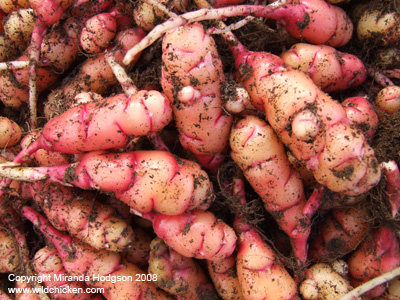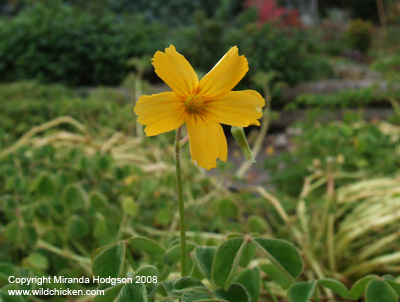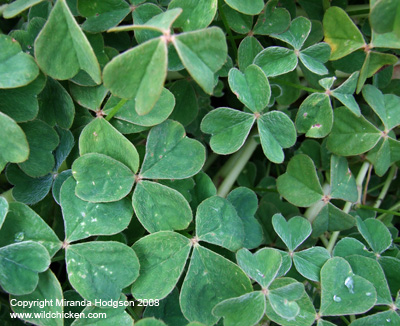



Oxalis tuberosa (also called Oca and New Zealand yam)
Oxalis
tuberosa
Tender perennial, treated as an annual in the UK, grown for its edible tubers which somewhat resemble pink, wrinkled carrots.
The tubers have a pleasant potato-like mealiness and the taste is like a new potato with a slightly lemony after-taste. The skins are soft and there is no need to peel them - they can be boiled for about 15 minutes, added to stews, baked or ground and used as a flour. It is said that the tubers become sweet if left in the sun for a few days - they don't turn green, as potatoes do, as they don't contain the same toxin, solanine.
Oxalis tuberosa originates from South America and was at one time a major staple, of similar importance to the potato. The attraction of growing it in the UK is that it doesn't appear to suffer from potato blight which causes problems in wet summers.
The plant does not start to produce tubers until day and night are of equal length, so you cannot expect to harvest before the end of October at the earliest. If frost is forecast, protect the plants with horticultural fleece or sheets of newspaper. Wait until the foliage has died away before harvesting as the tubers will continue to grow.
Oxalis tuberosa is said to produce a 1kg or more of tubers per plant. We didn't weigh ours, but averaged about 30 tubers per plant. I reckon you could improve on this if the plants were grown in the ground, rather than in containers, as we did.
For some more information, there is an article on Growing Oca (Oxalis tuberosa) in the UK.
Attractive foliage in summer, tubers produced in autumn.
Habit - upright at first, turning lax as it grows. H: up to 50cm. S: up to 1.5m.
Stem - round, pale green, fleshy-looking.
Leaves - mid-green, trifolate, covered in fine, downy hairs.
Flowers - simple, open, yellow, 5-petalled. Produced above foliage on straight, upright, slender stems. Few flowers are produced and they rarely set fruit.
Tubers - knobbly, cylindrical, up to 8cm long in shades of pink.
Full sun.
Reputed to tolerate a wide range of soil types and pH, though dislikes boggy ground.
Said to be tolerant of cold, but foliage dies back if exposed to frost. If the tubers have established, however, the foliage will probably regrow.
Little needed, as far as I've seen. The top growth becomes so dense by late summer that it blocks out most weeds, though the usual culprits (bindweed, nettles, etc) will still get through. Water during dry spells and feed as you would any other vegetable.
I am unsure if the plant is susceptible to slugs and snails as our plants didn't suffer from either pest.
As with potatoes, save tubers in a cool dark place, in sand or sawdust, and chit and plant out in spring after the danger of frost has passed. We started ours in 10cm pots indoors and planted them out when they were about 10cm high.